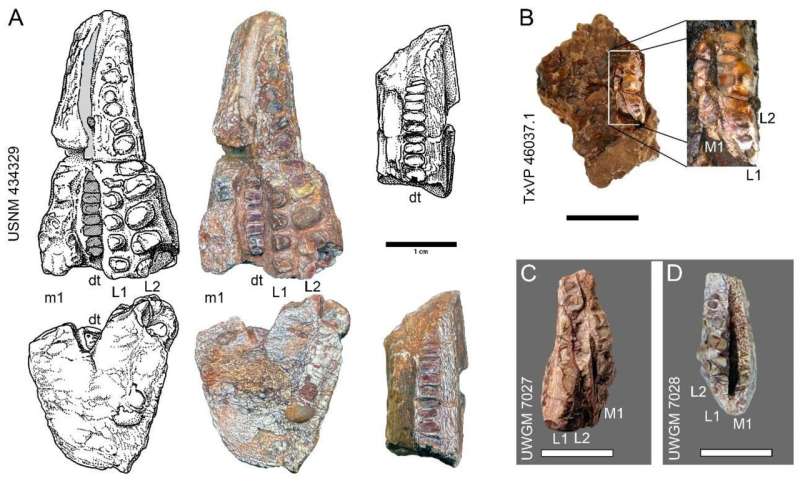April 27, 2023 report
This article has been reviewed according to Science X's editorial process and policies. Editors have highlighted the following attributes while ensuring the content's credibility:
fact-checked
trusted source
proofread
New rhynchosaur, named Beessiiwo cooowuse, found in Wyoming

Once upon a time, in what is now Wyoming, the predecessors of birds, alligators, and dinosaurs roamed the range. A lizard-like creature with a beak that ate plants around 232 million years ago has been described in a paper published in the journal Diversity.
The new taxon, described in "A New Rhynchosaur Taxon from the Popo Agie Formation, WY: Implications for a Northern Pangean Early-Late Triassic (Carnian) Fauna," by University of Wisconsin-Madison researchers, was found previously, but the initial specimens' surface texture and morphological features were too eroded for comparative use.
Using the unique dental morphology of 12 new specimens allowed paleontologists to confirm it as a new Rhynchosauria. Five specimens contained enough morphological information to identify it as belonging to Hyperodapedontinae, a subfamily of rhynchosaurs.
The taxonomic name of the new beast, Beessiiwo (Bah—se—wa) cooowuse ( ja' aw-wu sa), was created by the studies First Nation co-authors in the Arapaho language meaning "big lizard from the Alcova area" (Alcova being an area of central Wyoming), as the specimens were collected on lands of the Northern Arapaho. This big lizard was small by the standard of the big reptiles that would later dominate the landscape at about a half meter in length.
The fossils were found in the Popo Agie Formation of Wyoming, a layer of sediment deposited in the Triassic era in what would have been rivers or lake beds at a time when Wyoming was part of the Northern Pangean supercontinent hundreds of millions of years ago.
Finding the fossils, describing them and naming the new species may have been the easy part, as defining exactly where they fall into the Late Triassic Carnian lexicon of lizards proved a more complicated task. It was a time of significant early diversification, so overlapping definitions based on past finds, which may be tens of millions of years apart, sharing traits from common ancestors but as evolutionarily distant as apes and monkeys, has resulted in numerous classification schemes falling in and out of favor.
Additionally, many diverse taxons of these related creatures lived in proximity, with overlapping territories and are occasionally found co-mingled in some sites, confounding even the most dedicated paleontologist. Beessiiwo cooowuse was most similar to, and likely a sister species of, the recently described Oryctorhynchus bairdi found in Nova Scotia, Canada, but it was not an exact match. After attempting to fit Beessiiwo into any of the available categories, the researchers decided it was best to give it one of its own.
The authors also note that yet unknown early to late Triassic fauna are waiting to be discovered in Wyoming. Few places in North America have as much surface access to this truly ancient nonmarine continental strata, and the Popo Agie Formation extends from west-central Wyoming through northeastern Utah and parts of Colorado.
More information: Adam J. Fitch et al, A New Rhynchosaur Taxon from the Popo Agie Formation, WY: Implications for a Northern Pangean Early-Late Triassic (Carnian) Fauna, Diversity (2023). DOI: 10.3390/d15040544
© 2023 Science X Network





















